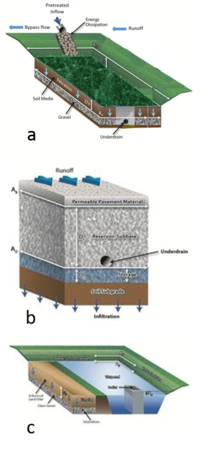
Difference between revisions of "Stormwater filtration Best Management Practices"
m |
m |
||
| Line 5: | Line 5: | ||
To see an overview of filtration BMPS, see [[BMPs for stormwater filtration]]. | To see an overview of filtration BMPS, see [[BMPs for stormwater filtration]]. | ||
| − | + | ==Stormwater control practices having an underdrain== | |
| + | The following practices typically employ an underdrain, which captures most of the runoff that enters the BMP. For information on these BMPs with no underdrain, see [[Stormwater infiltration Best Management Practices]]. | ||
*[[Permeable pavement]] ([[Permeable pavement combined|+]]) | *[[Permeable pavement]] ([[Permeable pavement combined|+]]) | ||
*[[Trees]] | *[[Trees]] | ||
| Line 17: | Line 18: | ||
<!--*[[Modular treatment wetlands for stormwater management]]--> | <!--*[[Modular treatment wetlands for stormwater management]]--> | ||
| − | + | ==Other filtration BMPs, including pretreatment practices== | |
*[[Green roofs]] ([[Green roofs combined|+]]) | *[[Green roofs]] ([[Green roofs combined|+]]) | ||
*[[Turf]] | *[[Turf]] | ||
*[[Vegetated filter strips]] | *[[Vegetated filter strips]] | ||
| + | *[[Pretreatment - Filtration devices and practices]] | ||
'''Manufactured devices''' | '''Manufactured devices''' | ||
| − | *[[Manufactured treatment devices]] | + | *[[Manufactured treatment devices]] - permanent structural practices that receive phosphorus and TSS removal credits |
| − | *[[Filtration devices]] | + | *[[Filtration devices]] - this page was in the original Minnesota Stormwater Manual and is now considered outdated |
'''Other links''' | '''Other links''' | ||
Revision as of 23:40, 16 November 2021
Filtration Best Management Practices (BMPs) treat urban stormwater runoff as it flows through a filtering medium, such as sand or an organic material. They are generally used on small drainage areas (5 acres or less) and are primarily designed for pollutant removal. They are effective at removing total suspended solids (TSS), particulate phosphorus, metals, and most organics. They are less effective for soluble pollutants such as dissolved phosphorus, chloride, and nitrate. Their effectiveness for bacteria varies with BMP. Link here for information on pollutant removal. Most filtration BMPs will achieve some volume reduction, depending on the BMP design. See information on credits for each BMP.
To see an overview of filtration BMPS, see BMPs for stormwater filtration.
Stormwater control practices having an underdrain
The following practices typically employ an underdrain, which captures most of the runoff that enters the BMP. For information on these BMPs with no underdrain, see Stormwater infiltration Best Management Practices.
- Permeable pavement (+)
- Trees
- Bioretention - biofiltration
- Dry swale (Grass swale) (Dry swale with underdrain) (+)
- Wet swale (wetland channel) (+)
- High-gradient stormwater step-pool swale (step pool with underdrain)
- Sand filter
- Iron enhanced sand filter (Minnesota Filter) (+)
Other filtration BMPs, including pretreatment practices
Manufactured devices
- Manufactured treatment devices - permanent structural practices that receive phosphorus and TSS removal credits
- Filtration devices - this page was in the original Minnesota Stormwater Manual and is now considered outdated
Other links
To view all pages for a particular BMP, click on "+"
